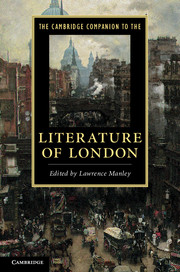Book contents
- Frontmatter
- Introduction
- 1 Images of London in medieval English literature
- 2 London and the early modern stage
- 3 London and the early modern book
- 4 London and poetry to 1750
- 5 Staging London in the Restoration and eighteenth century
- 6 London and narration in the long eighteenth century
- 7 London and nineteenth-century poetry
- 8 London in the Victorian novel
- 9 London in Victorian visual culture
- 10 London in poetry since 1900
- 11 London and modern prose, 1900-1950
- 12 Immigration and postwar London literature
- 13 Writing London in the twenty-first century
- 14 Inner London
- Guide to further reading
- Index
9 - London in Victorian visual culture
Published online by Cambridge University Press: 28 September 2011
- Frontmatter
- Introduction
- 1 Images of London in medieval English literature
- 2 London and the early modern stage
- 3 London and the early modern book
- 4 London and poetry to 1750
- 5 Staging London in the Restoration and eighteenth century
- 6 London and narration in the long eighteenth century
- 7 London and nineteenth-century poetry
- 8 London in the Victorian novel
- 9 London in Victorian visual culture
- 10 London in poetry since 1900
- 11 London and modern prose, 1900-1950
- 12 Immigration and postwar London literature
- 13 Writing London in the twenty-first century
- 14 Inner London
- Guide to further reading
- Index
Summary
Over 150 years separate Hogarth's etching and engraving of Gin Lane (see Figure 9.1) from Walter Richard Sickert's painting The Camden Town Murder; or, What Shall We Do about the Rent? (Figure 9.2). However, a particular view of London, one that is geographically and socially specific, as well as morally charged, envelops both of these representations. Gin Lane, normally paired with the more prosperous and cheerful London of Beer Street, was Hogarth's attempt to influence the passage of the Gin Act to regulate the sale of spirits that was driving the London poor to theft, murder, and suicidal despair. His grim satirical engraving, set in the notorious district of St Giles, with Hawksmoor's St George's Church peeping up behind the decrepit scrim of tenements, reduces social life to the pawn shop, the distillers, and the undertakers. The gin-sodden poor gnaw bones with the animals, while the negligent mother at the perspectival heart of the composition commits careless infanticide.
- Type
- Chapter
- Information
- The Cambridge Companion to the Literature of London , pp. 160 - 179Publisher: Cambridge University PressPrint publication year: 2011
- 1
- Cited by

